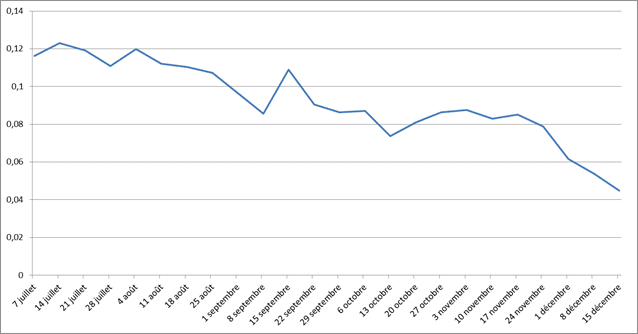The numbers prove that Facebook really wants us to buy advertising
Facebook attaches great importance to its advertising tools. This is also where he makes a very good part of his money. We hear more and more people say that “Facebook forces us to buy advertising so that our followers see our publications”. We wanted to see if that was true. We decided to look at the statistics of Facebook pages of businesses of different sizes across Quebec . We have compiled the statistics of 39 pages with 10,000 to 100,000 subscribers. Here are the results obtained from Facebook statistics.
We decided to look at the percentage of subscribers joined organically each day by Pages . To do this, we looked at the organic reach statistic in number of subscribers compared to the current number of subscribers. We then averaged by week since the number of subscribers reached during the weekend is lower.
Here is a graph showing the variation in the number of subscribers reached by the pages daily, organically, from July 1 to December 20, 2013.

While in July, pages reached organically between 11% and 12% of subscribers, this percentage drops to 5% in December, a drop of more than 50%.
Before continuing, it is important to define the different scope types:
- Organic reach: Users who saw the post as a result of the page's normal post
- Viral reach: Users who saw the post as a result of a share from a user other than the page
- Paid Reach: Users who saw the post as a result of a page promotion
An interesting piece of data is the correlation between paid reach and viral reach . This correlation is 0.35; it's not what you would call strong. On the other hand, it is a greater correlation than if we look between viral reach and organic reach and between organic reach and paid reach.
We can therefore conclude that if we add advertising, we have (a little) more chance of being shared by users.
On the other hand, when it comes to user engagement, the greater the reach, the lower the engagement rate. Indeed, the correlation coefficient between the sum of the number of impressions (viral, organic and paid) and the number of engaged users is negative. This means that even if you pay to have more reach, the engagement does not increase proportionally . This is especially the case when we advertise to increase the reach of a publication, but the publication does not lead to interaction.
It is therefore necessary to understand that it is not because we put advertising on a publication that it will have a better engagement rate than other publications. Above all, you must have a publication that will be interesting, useful or entertaining for the user to attract their attention . A publication that is not intended for interaction will not be able to give extraordinary results even if we decide to promote it through advertising. You must therefore think before using advertising and ask yourself if the publication is in line with the objectives of the social media strategy in place.
If I could conclude in one sentence: Use advertising to increase the reach of your publications when these are important for the social media strategy in place and when they will interest your subscribers.
Read more on Infopresse .
.jpg)

-Sep-07-2022-08-25-30-70-AM.png)

.jpg)









